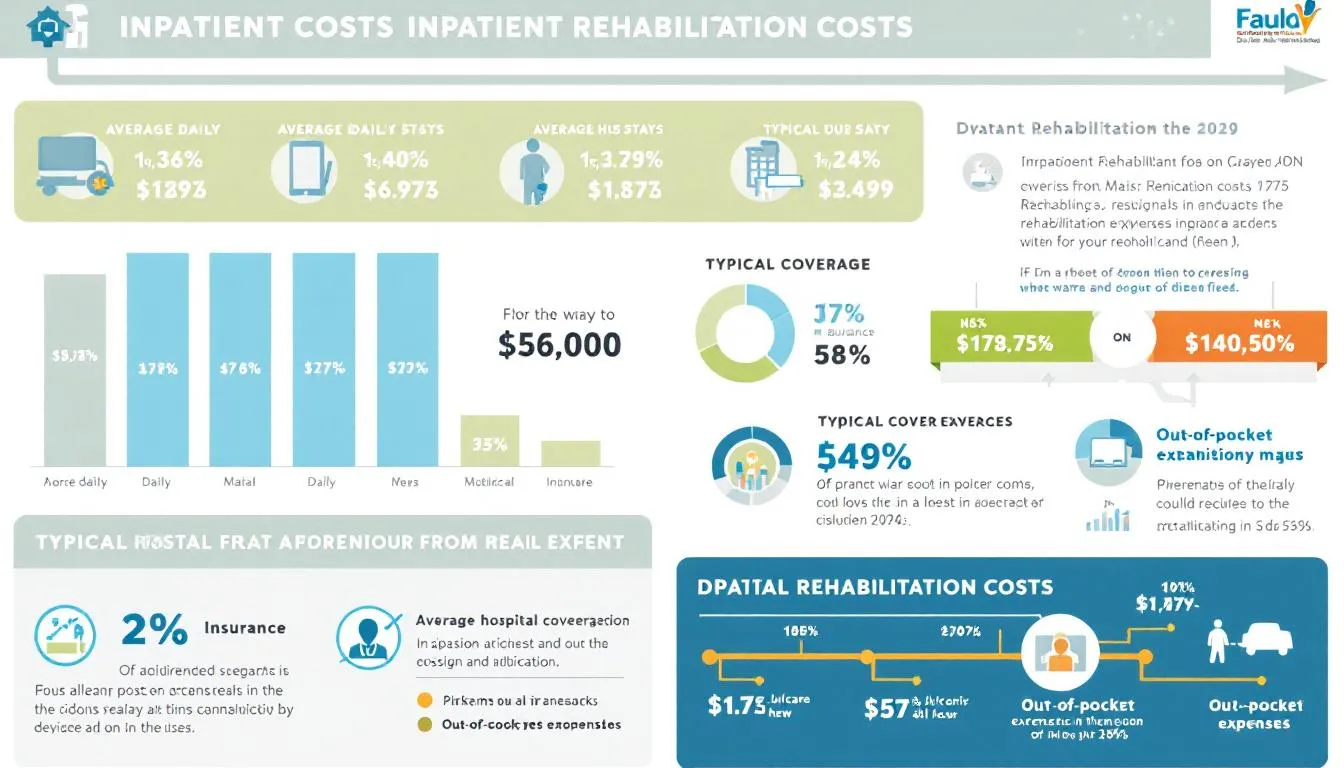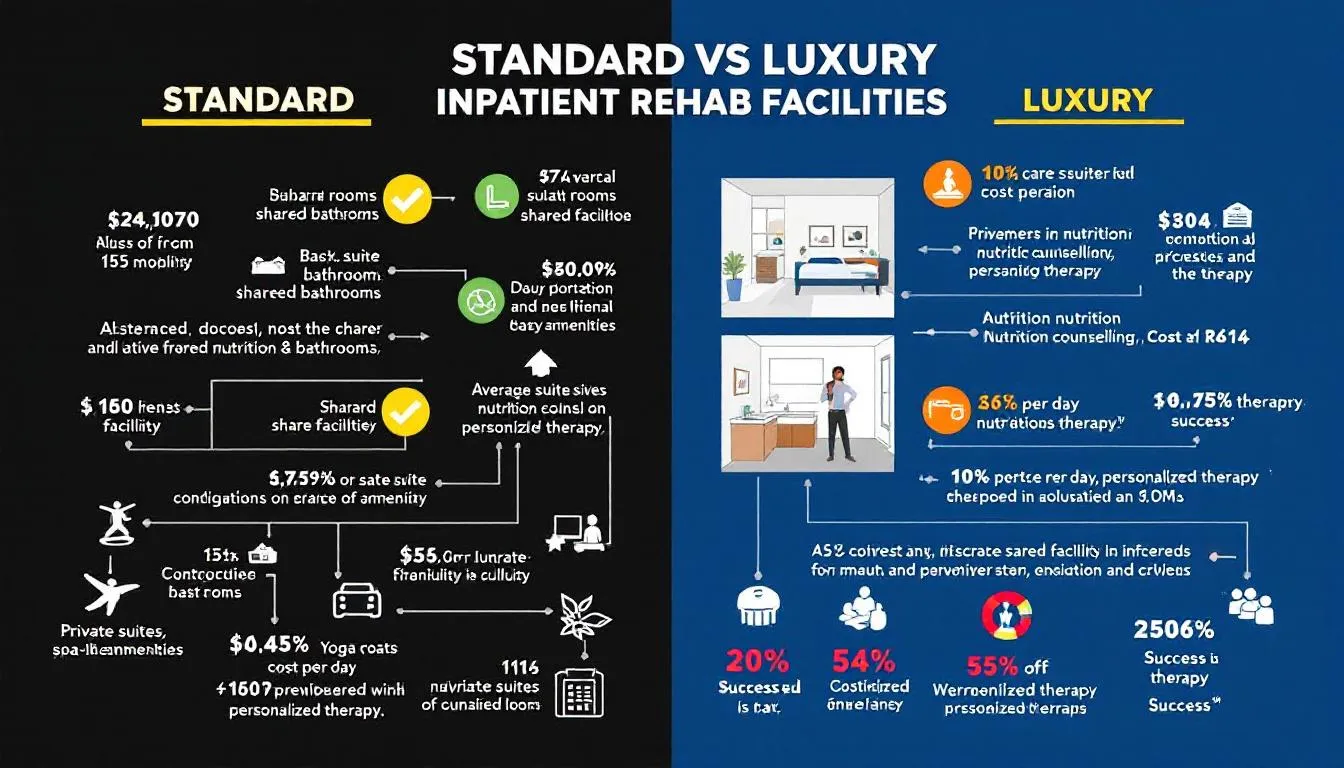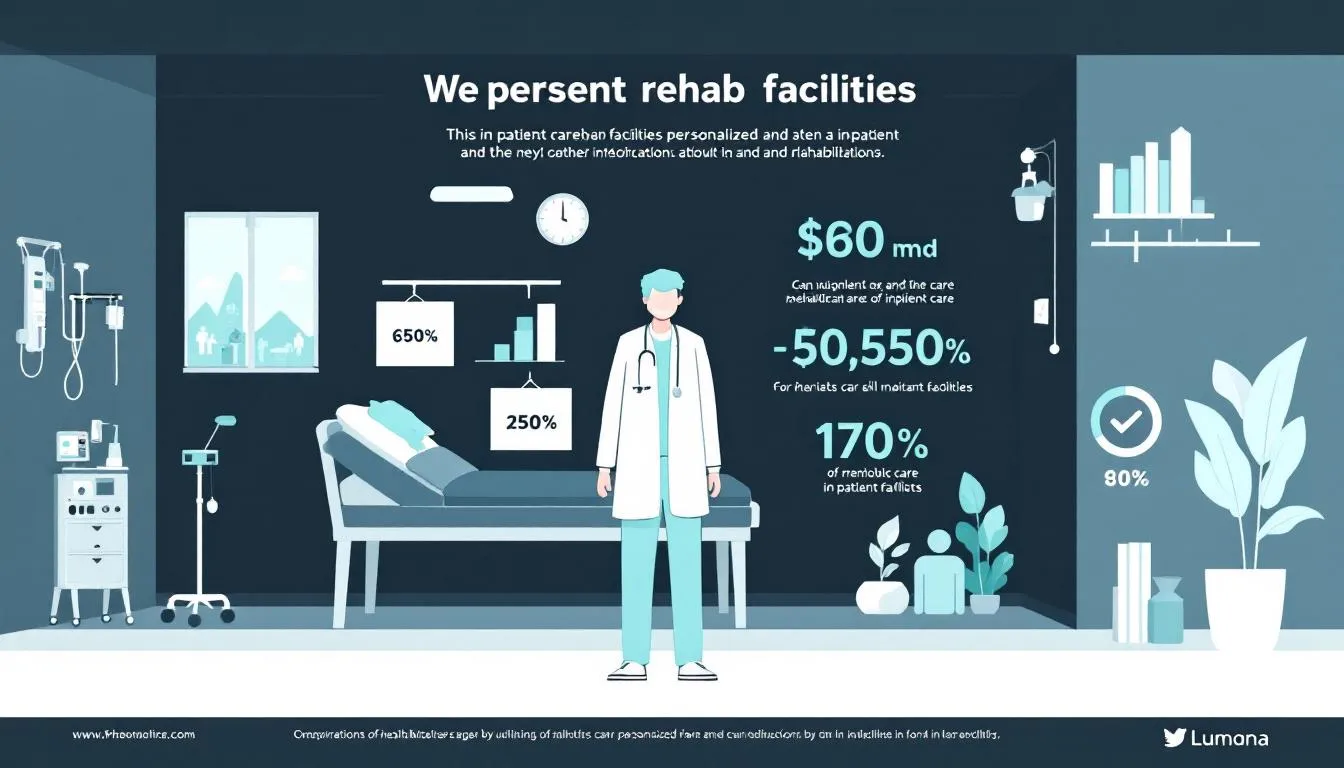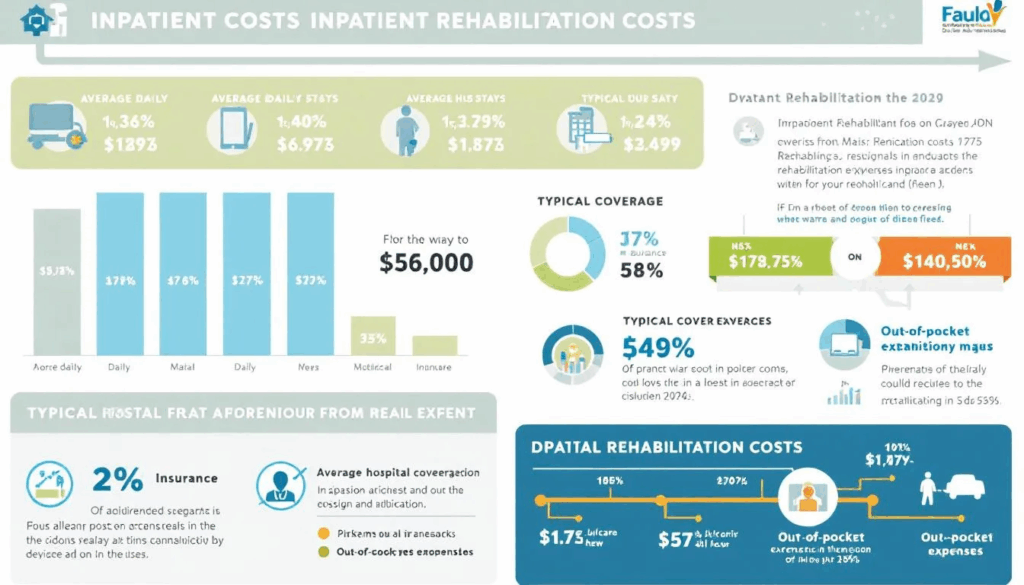The cost of inpatient rehab facilities can vary considerably, but on average, you can expect to pay between $500 and $2,000 per day for inpatient rehab facility cost per day. This range covers a wide spectrum of treatment options and amenities, from basic care to luxury accommodations. In this article, we’ll break down the factors influencing these costs to help you make an informed decision.
Key Takeaways
- Understanding the costs of inpatient rehab is essential for budgeting and planning, with average costs ranging from $5,000 to $30,000 monthly depending on program length and amenities.
- Factors such as geographic location, facility quality and amenities, and treatment intensity significantly influence daily rates of inpatient rehab, with urban facilities often being more expensive.
- Insurance coverage and financial assistance options play an important role in managing rehab costs, highlighting the need for individuals to verify their insurance specifics and explore available support options.
Understanding Inpatient Rehab Costs

Balancing financial capabilities with the need for comprehensive addiction treatment involves understanding inpatient rehab costs. Evaluating rehab costs is crucial due to the significant financial impact of addiction on overall quality of life. Knowing the average costs for inpatient rehab aids individuals and families in planning for treatment. Factors such as the type of treatment and duration of stay significantly affect rehab costs. Additionally, insurance coverage plays a significant role in determining these expenses.
The costs of treatment can escalate, with variations depending on the specific program and its features:
- Some residential treatment centers can reach up to $80,000.
- Inpatient rehab programs usually have average cost monthly costs ranging from $5,000 to $30,000.
- Partial Hospitalization Programs generally cost between $350 to $450 per day.
- Extended inpatient rehab programs lasting 60 to 90 days can exceed $60,000, with rehab treatment costs varying significantly.
Being informed about these costs aids in effective budgeting and planning for necessary rehab services.
Long-term addiction treatment programs usually include costs for:
- Room and board
- Medical and therapeutic services
- Therapy sessions
- Meals
- Additional activities
- Drug addiction treatment
These components help individuals seeking treatment better understand where their money is going and how to allocate resources effectively.
Average Daily Cost of Inpatient Rehab

The average daily rehab cost range for inpatient rehab facilities varies widely depending on the program and amenities, typically starting from around $5,000 to $15,000 for short-term treatment. For example, a 30-day stay in some inpatient rehab facilities may cost around $6,000, while it can go up to $30,000 depending on the quality and services offered. Although these costs can seem daunting, understanding drug rehab cost is the first step toward making an informed decision.
Luxury rehab facilities offering high-end services can demand tens of thousands of dollars monthly, with some notable centers costing up to $20,000 for a 30-day program. These facilities often provide an array of amenities that justify the higher costs, such as:
- Private rooms
- Gourmet meals
- Extensive recreational activities For those who can afford it, these luxury options offer a more comfortable and personalized experience.
Longer inpatient programs:
- Range from 60 to 90 days
- Can cost between $12,000 and $60,000 depending on treatment intensity and services provided, including substance abuse treatment costs
- Are often necessary for individuals with severe addiction issues
- Offer long-term support needed for sustainable recovery
Factors Influencing Daily Rates
Daily rates of inpatient rehab facilities are influenced by several factors, including location, quality and amenities offered, and the intensity and range of treatment services provided. Each factor can significantly impact the overall cost, making it crucial to understand their roles in determining the final expense.
Location Impact on Cost
Geographic location critically affects the daily cost of inpatient rehab facilities. Rehab costs are typically higher in urban areas due to elevated living expenses and market demand. For instance, a rehab center in a bustling city like New York or Los Angeles will likely charge more than a similar facility in a rural area. This is due to the higher cost of living in urban environments, which translates to higher operational costs for the facility itself.
However, choosing a rehab facility should consider the quality of care and the specific needs of the individual seeking treatment, not just cost. Sometimes, the higher costs in urban areas are justified by access to better medical professionals, more advanced treatment options, and a broader range of support services.
Facility Quality and Amenities
The overall daily cost is significantly influenced by the quality of the rehab facility. Amenities available at the facility also play a significant role in the overall cost. Higher quality rehab facilities often offer luxurious amenities such as private suites, chef-prepared meals, pools, and state-of-the-art gyms, substantially increasing daily costs. For example, Ritz Recovery offers specialized programs like couples rehab, holistic therapy, and trauma-informed care, enhancing the overall luxury rehab experience.
Certifications and accreditations also indicate a rehab center’s commitment to quality. Facilities investing in these credentials often provide a higher standard of care, reflected in their pricing. When evaluating rehab facilities, it’s important to consider these aspects to ensure that the cost aligns with the quality of care and the amenities offered.
While higher-quality facilities with extensive amenities can be more expensive, they might offer a more comfortable and supportive environment for recovery. This can be particularly beneficial for those who need a higher level of care and support to overcome their addiction.
Treatment Intensity and Services Provided
Comprehensive services like medical supervision and therapy sessions can elevate the daily rates for inpatient rehab. Initial costs in the first week of rehabilitation are often higher due to extensive medical and surgical supplies needed. For example, services typically included in inpatient care encompass 24/7 monitoring for acute psychiatric symptoms or crisis.
Common services in short-term rehabilitation treatment programs include rehabilitation services such as:
- Detox
- Individual and group therapy
- Educational sessions
- Relapse prevention planning
These components are essential for effective addiction treatment and can increase the overall cost. Long-term addiction treatment programs provide extended support and intensive care, which can also drive up costs.
In dual diagnosis treatment, services may include medical detox, medication-assisted treatment, and individual and group therapy sessions. The level of care and specific therapy services included can significantly impact the daily costs of inpatient rehabilitation. Understanding these factors helps individuals seeking treatment choose a program that best fits their needs and budget for mental health treatment, including outpatient detox and substance abuse treatment.
Comparing Standard vs. Luxury Inpatient Facilities

Comparing standard and luxury inpatient rehab facilities reveals clear differences in costs and services:
- Luxury rehab prices can reach between $20,000 and over $100,000 monthly.
- Standard facilities typically cost between $5,000 and $20,000.
- Standard facilities are more affordable than high-end options.
- Standard facilities may lack some amenities and specialized therapies offered by luxury centers.
Luxury rehab centers often allocate more funds toward amenities and marketing rather than purely clinical care. Key differences include:
- Basic programs are lower in cost.
- Luxury facilities charge more for specialized therapies and premium amenities.
- Luxury rehab options may exceed $60,000 for comprehensive care.
- Costs vary based on individual needs and length of stay.
While luxury facilities offer a more comfortable experience with additional amenities, it’s important to remember that the effectiveness of treatment is influenced more by the quality of therapy and duration rather than the luxury of the accommodation. Individuals should weigh the benefits of both options carefully to make an informed decision aligning with their recovery needs and financial capabilities.
Insurance Coverage for Inpatient Rehab

Insurance often covers inpatient rehab since it addresses a medical condition. The extent of health insurance coverage for rehab can vary widely depending on the specific health plan. Some facilities offer comprehensive services fully covered by insurance, aiding in navigating claims. This can significantly reduce out-of-pocket costs for individuals seeking treatment.
Under certain conditions, private insurance plans may be required to cover mental health services, including rehab. Public insurance options, like Medicaid, may help make rehab more affordable for those without private coverage. Key points about Medicaid coverage for substance use disorders include:
- Coverage varies by state
- Can include inpatient, outpatient, and long-term services
- Numerous facilities accept a range of insurance plans, including Medicaid
To verify your insurance coverage for addiction treatment, and for guidance on how to support a spouse with addiction, visit our resources.
- Inquire with your insurance provider to determine the specifics of coverage.
- Contact admission counselors to help verify coverage.
- Ensure your chosen facility is in-network to decrease out-of-pocket costs.
Verifying your health insurance coverage for rehab is important since details can vary widely depending on the policy and plan.
Financial Assistance Options
Various affordable options are available, and financial assistance programs can help manage the costs of inpatient rehab. Financial assistance can significantly reduce out-of-pocket rehab costs. Common types of financial assistance for rehab include:
- Grants
- Scholarships
- Employer assistance
- Government programs
State-funded rehab centers and nonprofit programs offer low-cost treatment options.
Community-based organizations often provide grants and scholarships to support rehabilitation expenses. Payment options for rehab can include flexible payment plans, sliding scale fees based on income, and various financing options. Individuals seeking financial assistance for rehab should explore local rehab facilities, nonprofit organizations, and state programs for support.
Long-Term Value of Inpatient Rehab
Investing in drug and alcohol rehab can lead to overall savings by reducing healthcare, legal, and relationship costs associated with untreated drug or alcohol addiction. The cost of drug rehab is outweighed by benefits like reduced drug use and associated costs. Paying for drug and alcohol addiction treatment is a valuable investment as it improves physical and mental health outcomes.
Evidence-Based Therapies (EBTs) are crucial for effective addiction treatment, regardless of the facility’s luxury status. The effectiveness of treatment is more influenced by the quality of therapy and duration rather than the luxury of the accommodation. Successful rehabilitation enhances mental and physical health, improves emotional stability, and boosts productivity.
Untreated drug addiction can lead to severe health issues, legal problems, strained relationships, and substantial costs. Individuals not receiving addiction treatment face higher risks of physical health issues, incarceration, and divorce. Investing in inpatient rehab leads to significant health improvements, opens new opportunities, and enhances overall quality of life, especially for those struggling with alcohol abuse, drug abuse, and substance abuse.
Choosing the Right Inpatient Rehab Facility

When selecting a rehab facility, it is crucial to:
- Identify personal treatment goals and needs, as different centers focus on varying specialties.
- Consult a treatment provider to understand available options and receive guidance in finding a program that fits recovery objectives.
- Research and compare multiple rehab centers to ensure they meet specific recovery needs and treatment preferences. For further guidance, see how to choose a rehab facility.
When choosing a facility, consider factors such as inpatient versus outpatient treatment, specializations in addiction types, and available therapeutic methods. Evaluating amenities provided by different treatment centers helps differentiate options and find a suitable environment for recovery.
The length of the treatment program varies, with many professionals recommending longer stays (90 days) for more effective recovery.
Summary
In summary, understanding the costs associated with inpatient rehab is essential for anyone seeking addiction treatment. From the average daily costs to the factors influencing these rates, such as location, facility quality, and treatment intensity, being well-informed can help you make better financial and recovery decisions. Comparing standard and luxury facilities, exploring insurance coverage, and considering financial assistance options can further ease the financial burden.
Investing in inpatient rehab is a valuable step towards a healthier, more fulfilling life. It not only addresses the immediate challenges of addiction but also provides long-term benefits that extend far beyond the treatment period. As you embark on this journey, remember that the right rehab facility is one that aligns with your recovery goals and financial capabilities. Your future self will thank you for making this important investment in your health and well-being.
Frequently Asked Questions
What factors influence the cost of inpatient rehab?
The cost of inpatient rehab is influenced by factors such as location, quality and amenities of the facility, treatment intensity, and the range of services offered. Considering these elements is essential for making an informed decision.
How much does a 30-day inpatient rehab program typically cost?
A 30-day inpatient rehab program typically costs between $6,000 to $30,000, influenced by the facility’s quality and services. It’s essential to consider these factors when evaluating your options.
Does insurance cover inpatient rehab costs?
Insurance typically covers inpatient rehab costs, though coverage levels can vary by plan. It is advisable to verify the specifics with your insurance provider.
What financial assistance options are available for inpatient rehab?
Financial assistance options for inpatient rehab include grants, scholarships, employer assistance, government programs, flexible payment plans, and sliding scale fees based on income. Exploring these options can help make treatment more accessible.
Why is investing in inpatient rehab considered valuable?
Investing in inpatient rehab is valuable as it significantly improves health outcomes, lowers long-term costs of untreated addiction, and enhances overall quality of life. This approach addresses the root of addiction effectively, providing lasting benefits.



